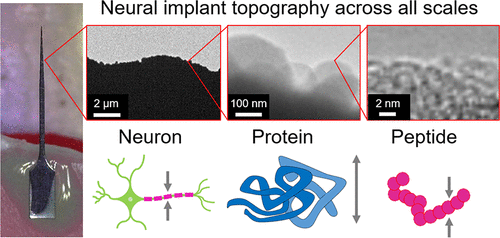Our official English website, www.x-mol.net, welcomes your
feedback! (Note: you will need to create a separate account there.)
Surface Area and Local Curvature: Why Roughness Improves the Bioactivity of Neural Implants
Langmuir ( IF 3.7 ) Pub Date : 2022-06-09 , DOI: 10.1021/acs.langmuir.2c00473 Ruikang Ding 1 , Nathaniel C Miller 1 , Kevin M Woeppel 2, 3 , Xinyan T Cui 2, 3, 4 , Tevis D B Jacobs 1
Langmuir ( IF 3.7 ) Pub Date : 2022-06-09 , DOI: 10.1021/acs.langmuir.2c00473 Ruikang Ding 1 , Nathaniel C Miller 1 , Kevin M Woeppel 2, 3 , Xinyan T Cui 2, 3, 4 , Tevis D B Jacobs 1
Affiliation

|
While roughening the surface of neural implants has been shown to significantly improve their performance, the mechanism for this improvement is not understood, preventing systematic optimization of surfaces. Specifically, prior work has shown that the cellular response to a surface can be significantly enhanced by coating the implant surface with inorganic nanoparticles and neuroadhesion protein L1, and this improvement occurs even when the surface chemistry is identical between the nanoparticle-coated and uncoated electrodes, suggesting the critical importance of surface topography. Here, we use transmission electron microscopy to characterize the topography of bare and nanoparticle-coated implants across 7 orders of magnitude in size, from the device scale to the atomic scale. The results reveal multiscale roughness, which cannot be adequately described using conventional roughness parameters. Indeed, the topography is nearly identical between the two samples at the smallest scales and also at the largest scales but vastly different in the intermediate scales, especially in the range of 5–100 nm. Using a multiscale topography analysis, we show that the coating causes a 76% increase in the available surface area for contact and an order-of-magnitude increase in local surface curvature at characteristic sizes corresponding to specific biological structures. These are correlated with a 75% increase in bound proteins on the surface and a 134% increase in neurite outgrowth. The present investigation presents a framework for analyzing the scale-dependent topography of medical device-relevant surfaces, and suggests the most critical size scales that determine the biological response to implanted materials.
中文翻译:

表面积和局部曲率:为什么粗糙度会提高神经植入物的生物活性
虽然粗糙化神经植入物的表面已被证明可以显着提高其性能,但这种改进的机制尚不清楚,从而阻碍了表面的系统优化。具体而言,先前的工作表明,通过用无机纳米粒子和神经粘附蛋白 L1 涂覆植入物表面,可以显着增强细胞对表面的反应,即使纳米粒子涂覆和未涂覆的电极之间的表面化学性质相同,也会出现这种改善,表明表面形貌的重要性。在这里,我们使用透射电子显微镜来表征从设备尺度到原子尺度的 7 个数量级大小的裸露和纳米粒子涂层植入物的形貌。结果揭示了多尺度粗糙度,使用传统的粗糙度参数无法充分描述。事实上,两个样本在最小尺度和最大尺度上的地形几乎相同,但在中间尺度上差异很大,尤其是在 5–100 nm 范围内。使用多尺度形貌分析,我们表明涂层导致可用接触表面积增加 76%,并且在与特定生物结构相对应的特征尺寸下,局部表面曲率增加了一个数量级。这些与表面结合蛋白增加 75% 和轴突生长增加 134% 相关。本研究提出了一个框架,用于分析医疗器械相关表面的尺度相关地形,
更新日期:2022-06-09
中文翻译:

表面积和局部曲率:为什么粗糙度会提高神经植入物的生物活性
虽然粗糙化神经植入物的表面已被证明可以显着提高其性能,但这种改进的机制尚不清楚,从而阻碍了表面的系统优化。具体而言,先前的工作表明,通过用无机纳米粒子和神经粘附蛋白 L1 涂覆植入物表面,可以显着增强细胞对表面的反应,即使纳米粒子涂覆和未涂覆的电极之间的表面化学性质相同,也会出现这种改善,表明表面形貌的重要性。在这里,我们使用透射电子显微镜来表征从设备尺度到原子尺度的 7 个数量级大小的裸露和纳米粒子涂层植入物的形貌。结果揭示了多尺度粗糙度,使用传统的粗糙度参数无法充分描述。事实上,两个样本在最小尺度和最大尺度上的地形几乎相同,但在中间尺度上差异很大,尤其是在 5–100 nm 范围内。使用多尺度形貌分析,我们表明涂层导致可用接触表面积增加 76%,并且在与特定生物结构相对应的特征尺寸下,局部表面曲率增加了一个数量级。这些与表面结合蛋白增加 75% 和轴突生长增加 134% 相关。本研究提出了一个框架,用于分析医疗器械相关表面的尺度相关地形,











































 京公网安备 11010802027423号
京公网安备 11010802027423号